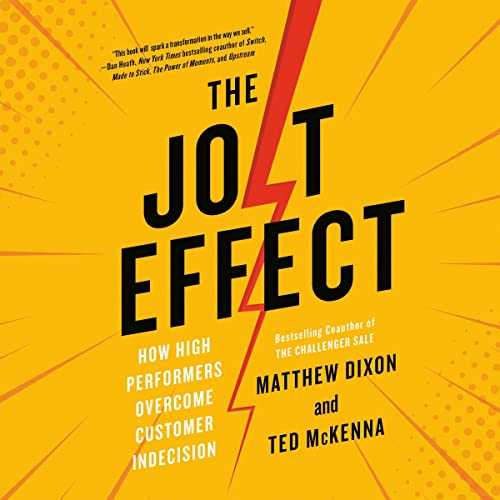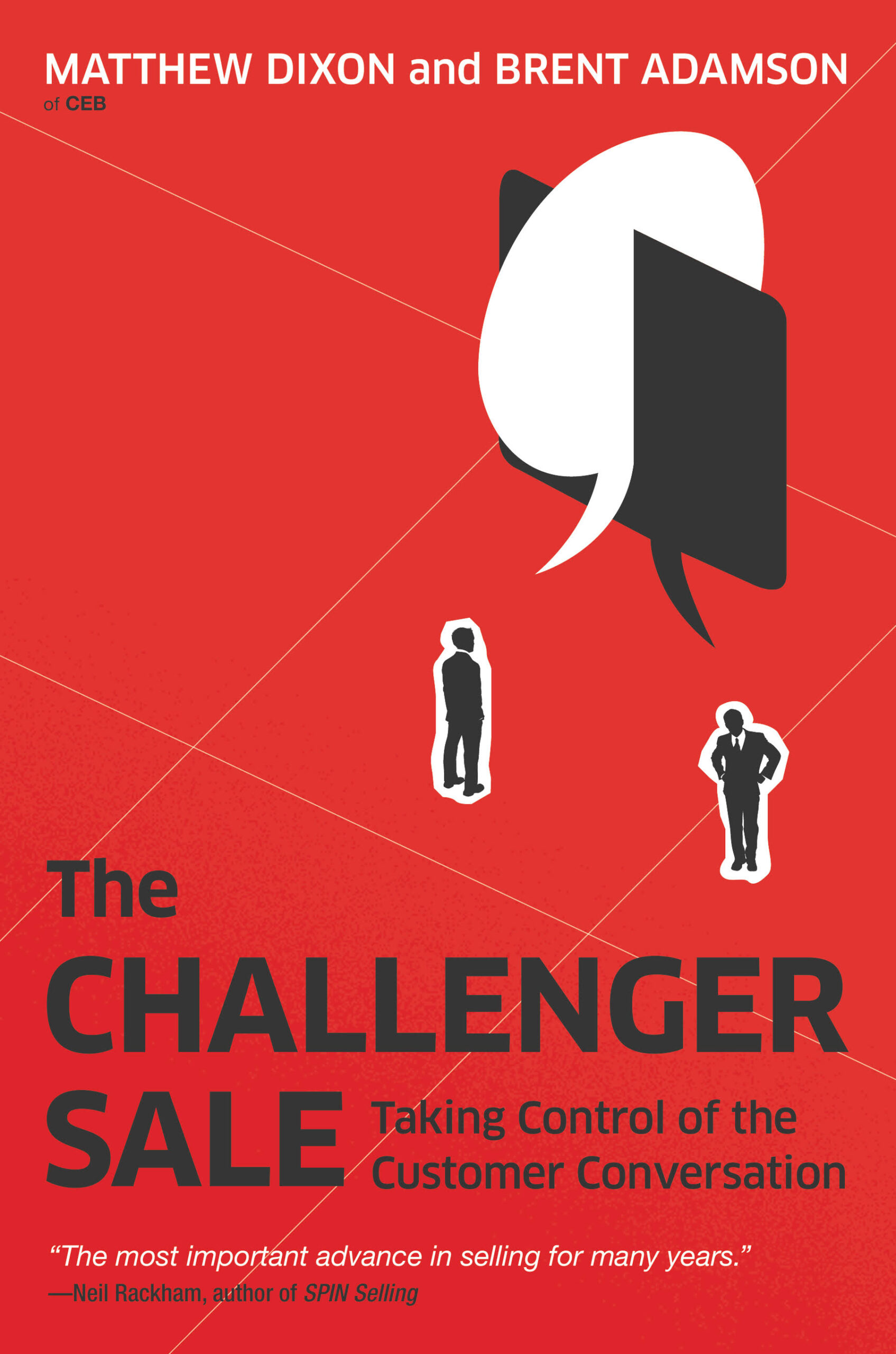In their book “The JOLT Effect: How High Performers Overcome Customer Indecision” by Matthew Dixon and Ted McKenna, 40-60% of all lost sales as a prospect progresses through the sales funnel are due to the prospect being unable to make a decision. So, there is a huge emphasis in sales methodology to try to get these indecisive prospects to become unstuck before it is too late.
During their research for the book, which involved reviewing 2.5 million sales calls, they discovered that a subset of salespeople were much better at closing deals. A further examination of these most successful salespeople led to the discovery of a four-step methodology to deal with an indecisive prospect they called the JOLT Effect. Jolt is an acronym for:
- Judge the indecision
- Offer your recommendation
- Limit the exploration
- Take the risk off the table
Judge the Indecision
Many salespeople fail to realize the source of a prospect’s indecision. While many tools and processes are defined to help determine the prospect’s needs and identify the markers that determine where they are along their sales journey, few processes address the ability to determine what was causing a prospect’s indecision.
Indecision is about fear, and fear is always personal in nature. Judging the source of the prospect’s indecision requires being an active listener to pick up on the prospect’s subtle clues. However, active listening is not enough. Salespeople need to go out of their way to make it okay for the prospect to discuss their fears.
One way to do this is by sharing that most people experience fear when making critical decisions. For example, as a salesperson, you could say to your prospect something like,
“Most people have a hard time deciding which plan to choose. I don’t want to assume that this is your issue, however, if it is something you are struggling with, you should know that this is completely normal. Are you struggling with this, and do you want to talk about it?”
You want to make the prospect feel it is okay to be confused so they are more likely to open up about the fear leading to their indecision. What often happens is that by making it okay and normal to share their biggest fears even if your assumption is incorrect, it often produces a redirect from the prospect, such as,
“Choosing the right plan is not my biggest point of confusion. It is the lack of a guarantee that I’ll see the ROI.” Getting the prospect to share their fear lets you know where to focus your attention.
The lesson in the “judge the indecision” step is to not assume that the only way to get a prospect to buy requires dialing up the Fear of Missing Out (FoMO) tactic. Instead, dial down their Fear of Messing Up (FoMU) by sharing that it is perfectly normal to have fear when making critical decisions, so they are more willing to share their real fear.
Offer your Recommendation
Barry Schwartz wrote a book called the “Paradox of Choice: Why More is Less” where he postulated that if you give your prospect too many choices, they get overwhelmed. However, it is not just a matter of reducing the number of choices. In the Paradox of Choice, they discuss an experiment known as the Jam Experiment.

A pair of research assistants from the Columbia Business School set up a sociological experiment. They went to a local grocery store and set up a sample table with different kinds of jellies. On the first day, they had 24 samples from which potential buyers could choose. They discovered that with 24 samples, they created a lot of interest from shoppers to try some of the samples. While they got about 145 shoppers to stop by their sample table for a tasting, by the end of the day, only four people (3%) decided to buy any of their jellies.
On the next day, they reduced the number of samples they offered to just six. That day they only had 104 shoppers stopped by their sample table, a statistically significant reduction in the number of shoppers due to the limited number of choices offered. However, 31 shoppers (30%) decided to buy at least one of their jellies.
The takeaway is that while more choices may draw more people in by painting “the art of the possible,” they soon become so overwhelmed by the fear of picking the wrong thing or deciding what not to buy that they resort to indecision. When faced with what not to buy, most salespeople go back to their needs analysis to help the customer.
I heard a great story researching this topic about why returning to the needs analysis is not always the best tactic.
Imagine you go to a new restaurant, and as you look over the many options on the menu, the waitress asks if you are ready to order. You reply that you are overwhelmed by the number of choices and ask for a recommendation. If the waitress responds with “What are you hungry for?” That is not much help in making a decision. This is analogous to the salesperson going back to the needs assessment. A better approach might be for the waitress to share some of her favorite dishes. In this way, the prospect’s decision involved a recommendation from the waitress. If it turns out to be a bad decision, they can psychologically blame it on the waitress and not take ownership of the bad decision.
The lesson in the “offer your recommendation” step is to help the indecisive prospect choose using proactive guidance and offering a few suggestions based on your greater knowledge of the options. In this way, you relieve the prospect of the fear of making a poor decision since they can blame you and avoid self-condemnation by saying they relied on the judgment of another person if the decision turns out to be a bad one.
Limit the Explorations
Most salespeople indulge every prospect’s request for more and more information, be that an additional white paper, another demo, or one more reference call. What Dixon and McKenna discovered was that the best salespeople took more control of the sales situation and did not indulge the prospect’s every request. They recognized that at some point no additional amount of information would ever satisfy the prospect’s desire. It is often impossible for prospects to consume all of the information out there to inform a purchase decision. In fact, the more information the prospect gets, the more they tend to get wound around the axle and make no decision.
When faced with a prospect always asking for more information so they can make an informed decision, the issue boils down to the prospect wanting to become an expert before deciding to buy. Rather than indulge the prospect so they can become an expert, the best salespeople in their study positioned themselves as the “trusted advisor.”
The first step in positioning yourself as a trusted advisor is to demonstrate your trustworthiness. Most prospects have what Dixon and McKenna call the Agency Dilemma, which in short, is the belief that the only thing any salesperson wants is to make the sale so they can collect a commission check. Prospects have been oversold so often that they approach every salesperson with shields up. They believe that all salespeople only provide the good and hide all the bad to make the sale.
One way to build trust with a prospect involves finding key moments during the sales conversation to steer customers away from more expensive options. Sharing that the prospect does not need the premium version of the product or every bell and whistle addon helps to set you up as a trusted advisor that cares more about their happiness and success than earning a big fat commission. Another way to build trust is to share some of the downsides or shortcomings of your solution and perhaps review and address a few negative reviews. By demonstrating that you are not there just to make the sale or sell them on something they do not need, the prospect begins to feel that you are more trustworthy.
If pressed for more content, the top salespeople in their research would provide a list of articles, podcasts, or videos that they feel contain all the salient information the prospect needs to make an informed decision. In some cases, the salesperson may even recommend marketing material from a competitor or even share that part of their end-to-end solution is not as good as a competitor’s and encourage the prospect to perhaps consider a hybrid solution that involves the best pieces from multiple companies.
The second step in positioning yourself as a trusted advisor is to demonstrate your expertise. Too often, when it comes to larger and more complex sales, the salesperson will drag along other experts to do part of the presentation. This makes the salesperson appear more like just a glorified admin that an expert advisor.
Now, this does not mean that you should never bring along experts in a support capacity to help close a deal. The difference was that the best salespeople in their study never seceded control to one of these other experts. The top salespeople always used these experts in a supporting role to answer questions from the prospect and never as the featured presenter or the star of the show.
The best salespeople anticipate and address questions the prospect has not yet asked. Addressing questions that the prospect has not yet asked shows them that you have experience selling this solution to other people just like them, and they do not need to be the expert themselves.
To be viewed as a trusted advisor, you need to prove that you are an expert with all the knowledge necessary to solve their problem. As an analogy, you would never take travel advice from someone who has never visited the place you plan to visit. In these situations, you would certainly not trust the advice, and you would certainly feel compelled to do your own research. The same is true for salespersons that have not demonstrated their expertise. You can never be seen as a trusted advisor if you have not demonstrated that you are an expert.
The lesson of the “limit the exploration” step is to position yourself as the prospect’s trusted advisor. To do this, you first need to demonstrate to the prospect that you are trustworthy by showing them that you care about their happiness and success over making the sale. And two, demonstrate that you are an expert so they do not have to be.
Take Risk Off the Table
Everybody has bought into something that was too good to be true and got burned as a result. We are so used to salespeople overcommitting and under-delivering that even when we are convinced their solution is right for us, we often hesitate to sign on the dotted line. Better to make no decision than to make one that will cost them in the end.
Top salespeople in Dixon’s and McKenna’s study often sold consulting services as part of a de-risking strategy. They suggested including a bunch of consulting hours to make sure the implementation ran smoothly. They even added that any unused hours could be rolled into something else, so the consulting hours acted more as an insurance policy than an up-sell.
Another way to de-risk the purchase was to encourage the prospect to buy a smaller solution that could be scaled over time. In this way, if the decision failed to meet the objectives, at least the error was less costly or painful.
Recently I purchased a new TV and sound bar for our home. The salesperson shared that many customers have problems mounting the TV to the wall and configuring the TV with the sound bar, home Wi-Fi, smart home devices, etc., and suggested that for $150, a technician could come to my house to unbox and set up everything.
Another way to take some risk off the table is to not set the expectation too high in the first place. Too many salespeople want the sale so badly they reference best-case scenarios. If the prospect bases their ROI on these best-case scenarios, they are often disappointed when they fail to achieve them. Therefore, the best salespeople set realistic expectations that they feel confident their solution will accomplish in spades.
The lesson of the “take risk off the table” step is to look for ways to remove as much risk from the decision as possible by not overselling the ROI up front and being creative in looking for ways that the prospect can save face if things go south.
Conclusion
40% to 60% of all lost sales occur because prospects are unable to make decisions. To address this, successful salespeople use a four-step methodology known as the JOLT effect:
- Judge the indecision
- Offer your recommendation
- Limit the exploration
- Take the risk off the table
By actively listening to prospects and making it okay for them to share their fears, salespeople can better understand the source of the prospect’s indecision and offer proactive guidance and a few suggestions based on their greater knowledge of the options to help prospects avoid becoming overwhelmed by too many choices.
How can you use the lessons of the JOLT Effect to improve your sales?












